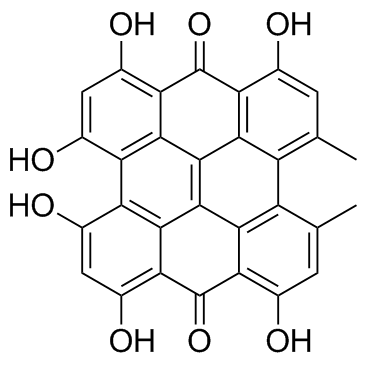Hypericin

Hypericin structure
|
Common Name | Hypericin | ||
|---|---|---|---|---|
| CAS Number | 548-04-9 | Molecular Weight | 504.443 | |
| Density | 1.9±0.1 g/cm3 | Boiling Point | 930.1±65.0 °C at 760 mmHg | |
| Molecular Formula | C30H16O8 | Melting Point | 299-301°C | |
| MSDS | Chinese USA | Flash Point | 530.1±30.8 °C | |
| Symbol |

GHS07 |
Signal Word | Warning | |
|
Phytochemical analysis and in vitro biological activity of three Hypericum species from the Canary Islands (Hypericum reflexum, Hypericum canariense and Hypericum grandifolium).
Fitoterapia 100 , 95-109, (2015) In the present work we carried out a phytochemical and biological investigation on three Hypericum species, i.e. Hypericum reflexum, Hypericum canariense and Hypericum grandifolium, from the Canary Islands where they are traditionally used as diuretic, wound ... |
|
|
Alterations in dysadherin expression and F-actin reorganization: a possible mechanism of hypericin-mediated photodynamic therapy in colon adenocarcinoma cells.
Cytotechnology 67(2) , 311-30, (2015) Dysadherin is a recently found anti-adhesion molecule, therefore detection and down regulation of its expression is promising in cancer treatment. The up-regulation of dysadherin contributes to colon cancer recurrence and metastasis. Dysadherin also has conne... |
|
|
Trend analysis of a database of intravenous pharmacokinetic parameters in humans for 670 drug compounds.
Drug Metab. Dispos. 36 , 1385-405, (2008) We present herein a compilation and trend analysis of human i.v. pharmacokinetic data on 670 drugs representing, to our knowledge, the largest publicly available set of human clinical pharmacokinetic data. This data set provides the drug metabolism scientist ... |
|
|
Hypericin-bearing magnetic iron oxide nanoparticles for selective drug delivery in photodynamic therapy.
Int. J. Nanomedicine 10 , 6985-96, (2015) Combining the concept of magnetic drug targeting and photodynamic therapy is a promising approach for the treatment of cancer. A high selectivity as well as significant fewer side effects can be achieved by this method, since the therapeutic treatment only ta... |
|
|
Photosensitizing effects of hypericin on head neck squamous cell carcinoma in vitro.
Eur. Arch. Otorhinolaryngol. 272(3) , 711-8, (2015) Clinical outcome of patients suffering from head neck squamous cell carcinomas is still poor due to recurrent disease and surgical limitations. There is still a demand for multimodality approaches and new therapeutic options. Hypericin is a promising phototox... |
|
|
Development of a novel formulation with hypericin to treat cutaneous leishmaniasis based on photodynamic therapy in in vitro and in vivo studies.
Antimicrob. Agents Chemother. 59 , 5804-13, (2015) An evaluation of the leishmanicidal activity in vitro and in vivo of hypericin, an expanded-spectrum photosensitizer found in Hypericum perforatum, is presented. Hypericin was evaluated against intracellular amastigotes in vitro of Leishmania (Viannia) paname... |
|
|
Transport and accumulation of PVP-Hypericin in cancer and normal cells characterized by image correlation spectroscopy techniques.
Biochim. Biophys. Acta 1843(5) , 855-65, (2014) PVP-Hypericin (PVP: polyvinylpyrrolidone) is a potent anti-cancer photosensitizer for photodynamic diagnosis (PDD) and therapy (PDT). However, cellular targets and mechanisms involved in the cancer-selectivity of the photosensitizer are not yet fully understo... |
|
|
Modifying excitation light dose of novel photosensitizer PVP-Hypericin for photodynamic diagnosis and therapy.
J. Photochem. Photobiol. B, Biol. 120 , 120-9, (2013) Conventional photodynamic diagnosis (PDD) and therapy (PDT) makes use of photosensitizers that are excited by continuous light irradiation of specific wavelengths. In the case of PDT, the overdose of continuous excitation may lead to an expansion of necrosis ... |
|
|
In vitro inhibition of Streptococcus mutans biofilm formation on hydroxyapatite by subinhibitory concentrations of anthraquinones.
Antimicrob. Agents Chemother. 51 , 1541-4, (2007) We report that certain anthraquinones (AQs) reduce Streptococcus mutans biofilm formation on hydroxyapatite at concentrations below the MIC. Although AQs are known to generate reactive oxygen species, the latter do not underlie the observed effect. Our result... |
|
|
PAL inhibitor evokes different responses in two Hypericum species.
Plant Physiol. Biochem. 63 , 82-8, (2013) Accumulation of secondary metabolites (general phenols, naphthodianthrones and phloroglucinol hyperforin) in Hypericum perforatum and Hypericum canariense after application of the inhibitor (2-aminoindane-2-phosphonic acid, AIP) of the pivotal enzyme of gener... |